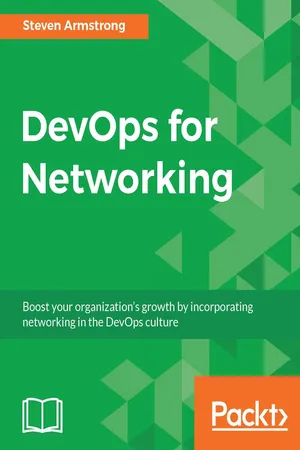
- 364 pages
- English
- ePUB (mobile friendly)
- Available on iOS & Android
DevOps for Networking
About this book
Boost your organization's growth by incorporating networking in the DevOps culture
About This Book
- Implement networking fundamentals to the DevOps culture with ease, improving your organization's stability
- Leverage various open source tools such as Puppet and Ansible in order to automate your network
- This step-by-step learning guide collaborating the functions of developers and network administrators
Who This Book Is For
The book is aimed for Network Engineers, Developers, IT operations and System admins who are planning to incorporate Networking in DevOps culture and have no knowledge about it.
What You Will Learn
- Learn about public and private cloud networking using AWS and OpenStack as examples
- Explore strategies that can be used by engineers or managers to initiate the cultural changes required to enable the automation of network functions
- Learn about SDN and how an API-driven approach to networking can help solve common networking problems
- Get the hang of configuration management tools, such as Ansible and Jenkins, that can be used to orchestrate and configure network devices
- Setup continuous integration, delivery, and deployment pipelines for network functions
- Create test environments for network changes
- Understand how load balancing is becoming more software defined with the emergence of microservice applications
In Detail
Frustrated that your company's network changes are still a manual set of activities that slow developers down? It doesn't need to be that way any longer, as this book will help your company and network teams embrace DevOps and continuous delivery approaches, enabling them to automate all network functions.
This book aims to show readers network automation processes they could implement in their organizations. It will teach you the fundamentals of DevOps in networking and how to improve DevOps processes and workflows by providing automation in your network. You will be exposed to various networking strategies that are stopping your organization from scaling new projects quickly.
You will see how SDN and APIs are influencing DevOps transformations, which will in turn help you improve the scalability and efficiency of your organizations networks operations. You will also find out how to leverage various configuration management tools such as Ansible, to automate your network.
The book will also look at containers and the impact they are having on networking as well as looking at how automation impacts network security in a software-defined network.
Style and approach
This will be a comprehensive, learning guide for teaching our readers how networking can be leveraged to improve the DevOps culture for any organization.
Frequently asked questions
- Essential is ideal for learners and professionals who enjoy exploring a wide range of subjects. Access the Essential Library with 800,000+ trusted titles and best-sellers across business, personal growth, and the humanities. Includes unlimited reading time and Standard Read Aloud voice.
- Complete: Perfect for advanced learners and researchers needing full, unrestricted access. Unlock 1.4M+ books across hundreds of subjects, including academic and specialized titles. The Complete Plan also includes advanced features like Premium Read Aloud and Research Assistant.
Please note we cannot support devices running on iOS 13 and Android 7 or earlier. Learn more about using the app.
Information
DevOps for Networking
Table of Contents
Table of contents
- DevOps for Networking